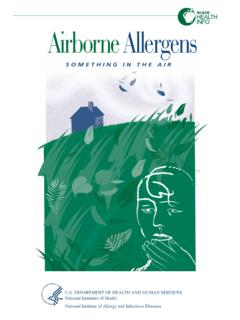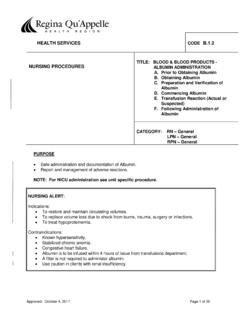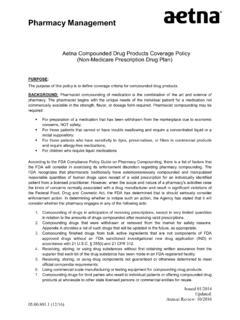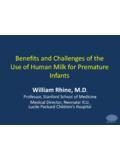Transcription of NIAID Food Allergy Overview (08-28-08)
1 food Allergy An DEPARTMENT OF HEALTH AND human services National Institutes of Health National Institute of Allergy and Infectious Diseases food Allergy An DEPARTMENT OF HEALTH AND human services National Institutes of Health National Institute of Allergy and Infectious Diseases NIH Publication No. 07-5518 July 2007 Contents 1 Introduction 2 What Is food Allergy ? 3 How Do Allergic Reactions Work? 6 Common food Allergies 7 food Allergy or food Intolerance? 11 Diagnosis 16 Treatment 19 food Allergy in Infants and Children 21 Some Controversial and Unproven Theories 25 Research 27 More Information 31 Glossary Introduction food Allergy affects up to 6 to 8 percent of children under the age of 3 and close to 4 percent of adults.
2 If you have an unpleasant reaction to something you have eaten, you might wonder if you have a food Allergy . One out of three people either believe they have a food Allergy or modify their or their family s diet. Thus, while food Allergy is commonly suspected, healthcare providers diagnose it less frequently than most people believe. This pamphlet describes allergic reactions to foods and their possible causes as well as the best ways to diagnose and treat allergic reactions to food . It also describes other reactions to foods, known as food intolerances, which can be confused with food Allergy , and describes some unproven and controversial food Allergy theories.
3 1 What Is food Allergy ? food Allergy is an abnormal response to a food triggered by the body s immune system. In this pamphlet, food Allergy refers to a particular type of response of the immune system in which the body produces what is called an allergic, or IgE, antibody to a food . (IgE, or immunoglobulin E, is a type of protein that works against a specific food .) Allergic reactions to food can cause serious illness and, in some cases, death. Therefore, if you have a food Allergy , it is extremely important for you to work with your healthcare provider to find out what food (s) causes your allergic reaction.
4 Sometimes, a reaction to food is not an Allergy at all but another type of reaction called food intolerance. food intolerance is more common than food Allergy . The immune system does not cause the symptoms of food intolerance, though these symptoms may look and feel like those of a food Allergy . 2 Note: Words in bold are defined in the glossary at the end of this booklet. How Do Allergic Reactions Work? An immediate allergic reaction involves two actions of your immune system Your immune system produces IgE. This protein is called a food -specific antibody, and it circulates through your blood.
5 The food -specific IgE then attaches to mast cells and basophils. Basophils are found in blood. Mast cells are found in body tissues, especially in areas of your body that are typical sites of allergic reactions. Those sites include your nose, throat, lungs, skin, and gastrointestinal (GI) tract. Generally, your immune system will form IgE against a food if you come from a family in which allergies are common not necessarily food allergies but perhaps other allergic diseases, such as hay fever or asthma. If you have two allergic parents, you are more likely to develop food Allergy than someone with one allergic parent.
6 If your immune system is inclined to form IgE to certain foods, you must be exposed to the food before you can have an allergic reaction. As this food is digested, it triggers certain cells in your body to produce a food -specific IgE in large amounts. The food -specific IgE is then released and attaches to the surfaces of mast cells and basophils. The next time you eat that food , it interacts with food -specific IgE on the surface of the mast cells and basophils and triggers those cells to release chemicals such as histamine. 3 Depending on the tissue in which they are released, these chemicals will cause you to have various symptoms of food Allergy .
7 food allergens are proteins in the food that enter your bloodstream after the food is digested. From there, they go to target organs, such as your skin or nose, and cause allergic reactions. An allergic reaction to food can take place within a few minutes to an hour. The process of eating and digesting food affects the timing and the location of a reaction. If you are allergic to a particular food , you may first feel itching in your mouth as you start to eat the food . After the food is digested in your stomach, you may have GI symptoms such as vomiting, diarrhea, or pain. When the food allergens enter and travel through your bloodstream, they may cause your blood pressure to drop.
8 As the allergens reach your skin, they can cause hives or eczema. When the allergens reach your mouth and lungs, they may cause throat tightness and trouble breathing. 4 Cross-Reactive food Allergies If you have a life-threatening reaction to a certain food , your healthcare provider will show you how to avoid similar foods that might trigger this reaction. For example, if you have a history of Allergy to shrimp, Allergy testing will usually show that you are not only allergic to shrimp but also to crab, lobster, and crayfish. This is called cross-reactivity. Another interesting example of cross-reactivity occurs in people who are highly sensitive to ragweed.
9 During ragweed pollen season, they sometimes find that when they try to eat melons, particularly cantaloupe, they experience itching in their mouths and simply cannot eat the melon. Similarly, people who have severe birch pollen Allergy also may react to apple peels. This is called the oral Allergy syndrome. 5 Common food Allergies In adults, the foods that most often cause allergic reactions include Shellfish such as shrimp, crayfish, lobster, and crab Peanuts Tree nuts such as walnuts Fish Eggs The most common foods that cause problems in children are Eggs Milk Peanuts Tree nuts Peanuts and tree nuts are the leading causes of the potentially deadly food Allergy reaction called anaphylaxis.
10 Adults usually keep their allergies for life, but children sometimes outgrow them. Children are more likely to outgrow allergies to milk, egg, or soy, however, than allergies to peanuts. The foods to which adults or children usually react are those foods they eat often. In Japan, for example, rice Allergy is frequent. In Scandinavia, codfish Allergy is common. 6 food Allergy or food Intolerance? If you go to your healthcare provider and say, I think I have a food Allergy , your provider has to consider other possibilities that may cause symptoms and could be confused with food Allergy , such as food intolerance.








![Premarket Notification [510(k)] Submissions for Testing for …](/cache/preview/1/7/c/d/3/6/5/3/thumb-17cd3653bed96093b8fda5d566c37de2.jpg)
